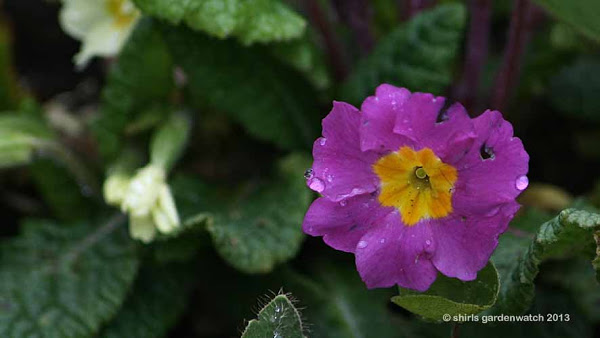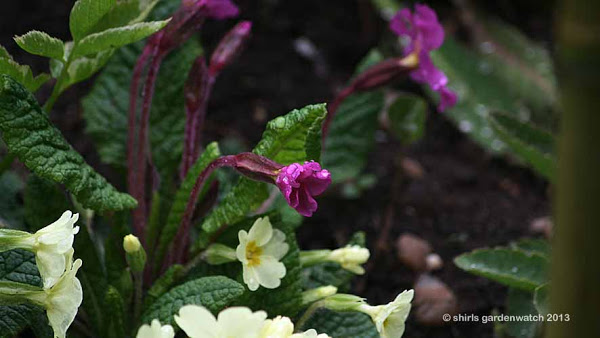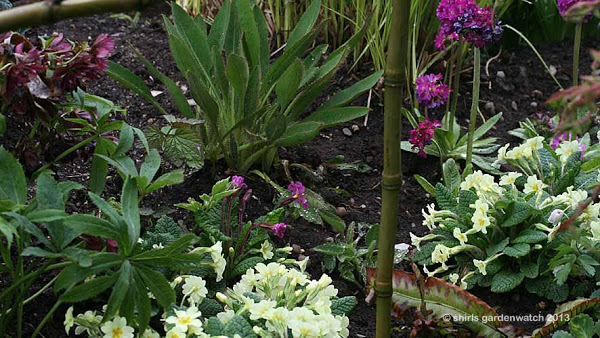What’s with the pink flowering native primroses? Spotted, this morning, alongside deep cerise pink drumstick primulas, I initially wondered if I was seeing a new primula species. A fun and exciting thought for a while!
Being realistic, I suspected this wasn’t likely so set about the world of Google searches. I asked on twitter too. It appears that in the wild there can be natural colour variances in native primroses, although the images I found looked much lighter in colour than my one below. Can anyone confirm that this what I have flowering in my garden? Oh… I love its deep pink stems.
It’s fair to say the (not planted by me) pink flowering primrose above is a pleasant addition to the native primroses (Primula vulgaris) that I grew from seed a good few years back and have lifted, divided and spread around my garden. Flowering their little hearts out around the mossy rocks edging my tiny pond they add so much to this partially shaded border especially when the wind picks up their heads and they bob about.
Oh yes… and the best part… bees are enjoying the en masse carpet of food too! I’ve seen quite a few feeding along this low nectar bar. How pretty it looks from my window… oh dear me… this gardenwatching lark is such a tedious thing to be doing 😉
This post was published by Shirley for shirls gardenwatch in May 2013.



Gorgeous!!! I would be thrilled to find these beauties in the garden!
I think all kinds ofbprimulas hibridise.
We have masses of native primroses as well as Victorian style Polyanthus. These have crossed with the primroses so we have lots of variations of pink and mauve promroses.
Shirley, as far as I know, not that much about gardening, if truth be told 😉 Primula are pretty promiscuous plants and they will hybridise easily. I've also learned that self seeded coloured drumstick Primula are much lighter in colour that the parent and are best divided to keep their colour.
It's a lovely colour. I have one similar that came from my brothers garden. I divided it and got 18 plants from a good size clump.
I'd also guess somewhere along the line a native primrose has cross pollinated with a cultivated variety as the shape doesn't look native either! Primroses and cowslips sometimes do this too.
I am not a plant expert but I am a professional admirer of beautiful blooms so that makes me expert at spotting a beautiful bloom. You have many in your garden including this little beauty.
Hi Shirley 🙂 I agree with the other comments and have seen the same in my garden over the years, where my native Primroses have hybridised with the commercially grown Primulas and Polyanthuses. Yours does look very pretty with the contrast of the pretty, pale yellow natives 🙂
I can only confirm that it is indeed beautiful. I can only imagine your heart skipping a beat at the thought of a new discovery. New or not, it deserves the excitement.
Hello everyone, thanks for all your comments 🙂 It’s been a while since I’ve been out with my camera or logged on here – my garden and other stuff have kept me busy. I hope you are all enjoying your gardens as much as I am this year – it’s great to reconnect 🙂
Chris, isn’t it just? I was delighted!
Celia, I hadn’t realised that they would hybridise – I’ve never seen this in my garden before and I grew these native ones many years ago. No polyanthus here but perhaps I should introduce another type now 😉
Angie, interesting to hear about the drumsticks loosing colour with self seeding. I’ve divided mine many times. I do love to propagate. Looking forward to waiting another year for this new pink one to bulk up and I’ll divide and spread it around too. You did well getting so many plants with your clump 😀
Sue, yes, I was wondering about the shape. Ah… this year I did plant a cowslip in my back garden so perhaps we will get some cross pollination going on this year too 😀
Lisa, a great way to put it! I’m loving so many blooms from my garden this year as my border dividing and re planting has rewarded me with wonderful drifts of colour. Haha you could say I’m still at the experimental gardener stage but then again I’ve always been that way 😉
Jan, this has been interesting to hear everyone agreeing with the hybridisation. The funny thing is though, I’ve had natives for many years and the drumstick primulas have been with me a few years now too. I have never seen this before. I have no other primulas or polyanthus but perhaps my neighbours do and that’s what’s happened here 🙂
According to Jim Carruthers (Scottish Natural Heritage) gardenwatching is probably the best thing to do for your garden. I filmed him giving this talk at Gardening Scotland about "How to not Garden" in order to improve a garden's biodiversity. Although he's being quite serious, this will make you smile!